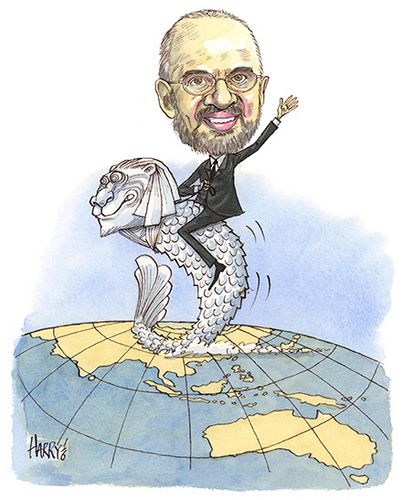Market conditions were far from benign in 2016, but one group picked its spots carefully, taking advantage of alternative sources of funding when the opportunity arose. For a series of groundbreaking issues across the capital structure, DBS Group is IFR Asia’s Issuer of the Year.
DBS Group made its mark on the global capital markets in 2016 with a series of well-timed trades that broadened its investor base and highlighted its ability to access low-cost funding.
Singapore’s biggest bank has traditionally been an infrequent issuer outside its home base, but it broke new ground in China, Hong Kong, Australia and in the US dollar market during the review period and issued across the capital structure, from covered bonds to senior unsecured and subordinated bank capital.
The breadth of issuance furthered DBS’s reputation as a sophisticated operator, while the terms it achieved confirmed that global investors were willing to pay a premium for the group’s securities.
“The AT1 we did was a world record, at the tightest pricing on an AT1 by a long measure, and the covered bond issuance we did into the Aussie market was also extremely tightly priced and extremely well accepted,” said Piyush Gupta, DBS chief executive.
For Yeoh Hong Nam, head of wholesale funding, 2016 marked the culmination of years of effort to increase the group’s profile as an issuer and meet its Basel III requirements as efficiently as possible.
“We want to ensure we always have access to liquidity and to capital,” said Yeoh. “That means opening different markets and familiarising investors with the DBS story.”
“We had been laying the ground for when the right windows opened, and that was what happened in 2016.”
DBS Group’s first Additional Tier 1 offering in US dollars was the highlight of the year, pricing at the lowest coupon ever seen on a Basel III hybrid in that currency.
The US$750m perpetual non-call five securities priced on August 30 at 3.6%, comfortably inside the 4.25% record set earlier in the year by ICBC (Asia). It was further inside the bank’s European peers, with HSBC’s AT1s trading at 5.43% for a shorter call date in 2020.
Singapore’s loss-absorption triggers do not appear as strict as European standards, but if pricing alone is any guide, the deal positioned DBS as the safest bank in the world.
DBS had issued Basel III capital in Singapore before, but the opportunity to make its US dollar debut at such a low cost proved too good to refuse. Citigroup, Deutsche Bank, HSBC and Societe Generale joined DBS as bookrunners on the deal, which was rated A3/BBB (Moody’s/Fitch).
It also triggered a flurry of AT1 capital raisings across the region as other Asian lenders tried to follow suit, but none came close to matching the terms DBS had achieved. And as US rates sold off a couple of months later, a sub-4% yield on the riskiest form of loss-absorbing bank debt looks unlikely to be equalled any time soon.
Covering new ground
DBS also broke new ground in May with the first covered bond from an Asian issuer in Australia’s Kangaroo market, opening up a new funding channel as the senior secured format gains traction across the region.
DBS, which sold Singapore’s first covered bonds in US dollars as recently as July 2015, printed an upsized A$750m (US$540m) three-year floating-rate note at 77bp over three-month BBSW, inside guidance of 80bp area.
Covered bonds are new to Asia, and the Aussie dollar debut made DBS the first Asian issuer to venture beyond the G3 currencies. It has considered issuing in the more established euro market and eyed a sterling deal, but the Australian market offered an opportunity to diversify at the most attractive cost, equal to a negative rate in euros.
Again, the deal was no fluke.
“We are an Asian issuer and familiarity with the DBS name in Asia Pacific is very strong. So, from a strategic standpoint, it made a lot of sense,” said Yeoh.
“Feedback from the last US dollar issue was that investors would be keen on an Australian dollar issue if we were to consider another currency. It opens up new conversations with Australian investors, but it also opens up conversations with investors that could not get into the US dollar offering.”
DBS also reaped the rewards of an extensive marketing effort in the Asia Pacific region that included investor meetings in Sydney, Melbourne and Brisbane through a broad syndication team, assisted by Barclays, National Australia Bank, RBC Capital Markets and Westpac.
Orders reached a hefty A$1.3bn, dwarfing the A$400m book for a five-year covered bond from Canada’s CIBC in April and allowing DBS to increase to deal from an indicative A$500m.
The deal, off the bank’s US$10bn global covered bond programme, also helped boost DBS’s presence Down Under following the opening of its Sydney branch in September 2015.
Asian investors were again important to the success of the deal, buying 57% of the bonds. The participation of local buyers, however, justified the decision to target the Kangaroo format. Unlike senior unsecured Kangaroos from global banks, DBS’s covered bonds are repo-eligible with the Reserve Bank of Australia due to their Triple A ratings from Moody’s and Fitch.
Banks took 85% of the covered Kangaroo notes, while asset managers picked up 11%, official institutions 3% and others 1%. Australia accounted for 33% of the deal, and the remaining 10% went to Europe.
Six currencies
All told, DBS issued in six different currencies during the review period. It was the first foreign bank in China to issue Tier 2 capital in the onshore renminbi market, raising Rmb2bn (US$291m) in December 2015 at 4.3% with a 10-year maturity, callable after five years.
It was active in its home market, retiring S$626m (US$437m) of Basel II Tier 2 notes in a liability management exercise in January and replacing them with a S$480m five-year senior bond, priced at 2.78%. January also saw a S$250m 3.8% 12-year non-call seven Basel III Tier 2 issue that marked the first Singapore dollar Tier 2 from an Asian issuer since 2014.
DBS also turned heads in April with a Tier 2 issue in Hong Kong’s local market – the city’s first under Basel III.
The Hong Kong dollar market had been largely ignored in recent years, overshadowed by the internationalisation of the renminbi. But DBS found it offered a competitive rate, appealed to a new group of investors, and matched its operations in the city.
“This was about accessing cheap funding and capital for the Hong Kong business,” a banker familiar with the issue said at the time. “You’ve got to have new ideas and we’re pretty proud of it given that it is the first one. There wasn’t a market for this before.”
DBS also locked in arbitrage funding opportunities through private placements throughout the year. It tapped Taiwanese investors for over US$880m, including US$315m in April, and sold a ¥10bn (US$88m) Tier 2 bullet in a private placement in March.
Bankers across Asia were unusually quick to praise DBS for its efforts in 2016, grudgingly admitting that the AT1 had been a huge success.
Still, the group’s focus on price and the best opportunities meant it did not complete every issue it had planned. It considered a sterling covered bond in late 2015, and a euro covered in September 2016, only to divert its attention elsewhere.
While the group’s focus on price may have frustrated some DCM bankers, it also underlined DBS’s disciplined approach to issuance.
It also makes one thing clear: after a transformational year in 2016, there is plenty more to come.
To see the digital version of this report, please click here



